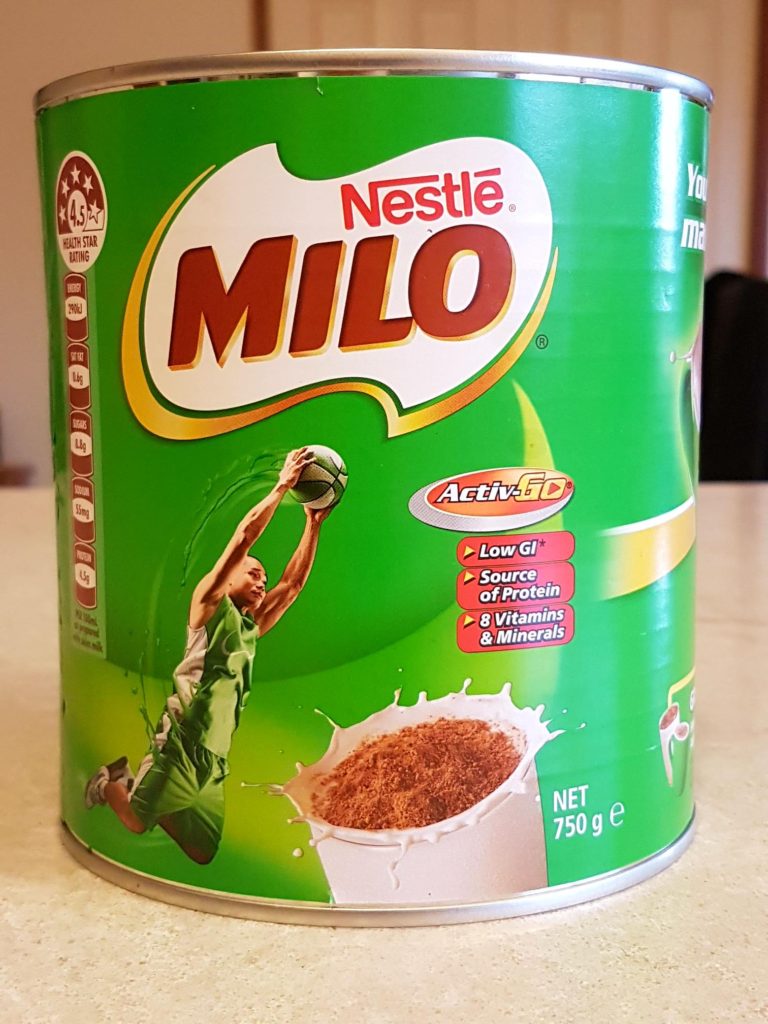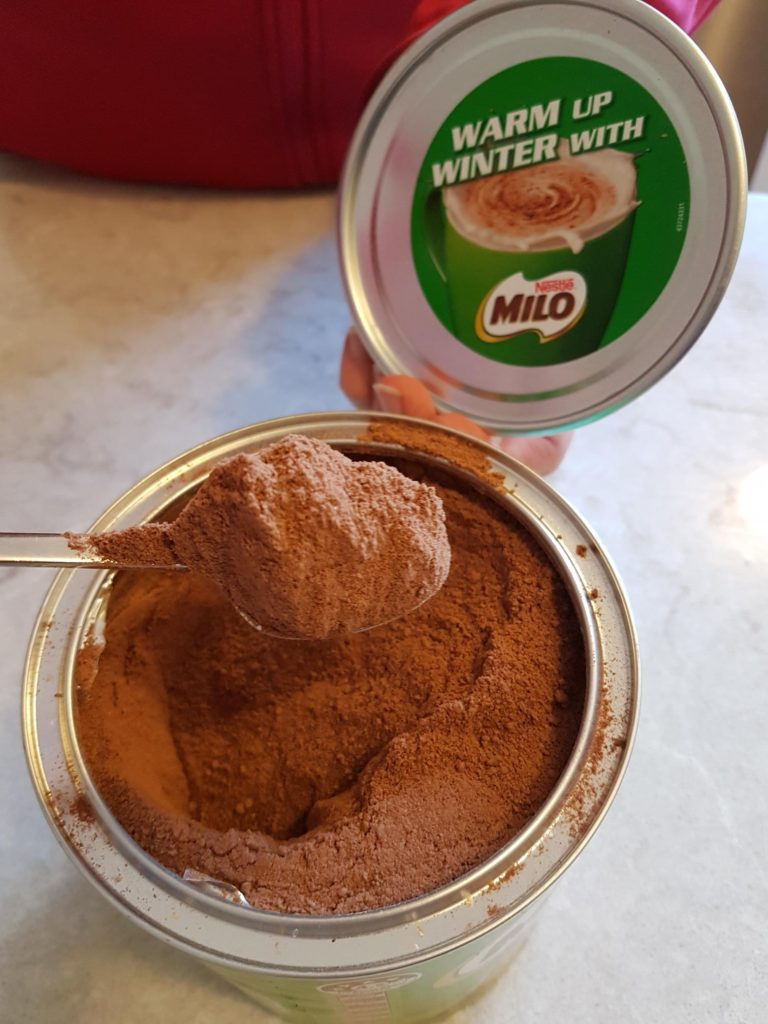Learn English while learning about daily life in Australia, with Rob McCormack
Podcast Number 92 – Milo
Hi,
Milo is a chocolate flavoured drink that is an Australian favourite. It’s also popular in other countries around the world, but it was invented in Australia in 1934 so we claim it as our own. In this podcast, I would like to tell you a little about this typically Australian drink.
Milo is made by the Nestle company, which operates in many countries around the world. It is named after a great athlete and wrestler, Milo of Croton, who lived in ancient Greece around 540 BC. In Australia, Nestle has a factory in the small town of Smithtown which is on the coast of New South Wales, around 450 km north of Sydney. That is where Australian Milo is made.
I can remember drinking Milo as a young child so it has been a part of my life since my earliest days. Even today, we still have a can of Milo sitting on our kitchen bench and occasionally I can’t resist making myself a hot cup of Milo. It is certainly still very popular in Australia so I think I am not alone. In fact, it is estimated that around 500 million cups of Milo are consumed every year in Australia.
Milo is made from malted barley, milk solids, cocoa (which gives it the chocolate taste) and sugar. It also has added vitamins and minerals which Nestle says makes it a healthy drink for children as well as adults.
You buy Milo in the form of a powder in a can and then you make it up into a drink. This is one of the reasons I like Milo. You decide how it is made. There are different ways to do that. Some people like to make it hot while others like it cold. Some people use all milk, while others use mostly water with some milk added. Perhaps some people even make it with just water, although I have never made it like that. Some people like 2 spoons of Milo, while others like 3 or perhaps even 4 spoons of Milo. The more spoons of Milo you use, the stronger the chocolate flavour. For me, there is also the question of how heaped the teaspoons should be. Milo as a powder sticks together very well, so I find you can put a lot on each spoon and make each teaspoon very heaped. Four heaped teaspoons of Milo is actually a lot of Milo. But in making Milo, there is always one rule – the more Milo, the better.
So here’s how I make a hot drink of Milo. You need a cup or mug, usually the largest one you can find, a can of Milo, a kettle to boil some water and some cold milk from the fridge. Put the kettle on to boil and put around 3 heaped teaspoons of Milo into your cup. When the kettle has boiled, pour some boiling water into your cup until the cup is around three quarters full. Now stir it around until the Milo is fully dissolved. Now top up the cup with a little cold milk and, hey presto, you have a hot cup of Milo.
If you want to make a cold Milo with mostly milk, then just use a small amount of boiling water. Put the Milo powder in the cup as before then pour the boiling water in until the cup is only about one quarter full. Stir it around with the spoon until the Milo is dissolved, then fill up the cup with cold milk. Then you will have a cold cup of Milo.
Of course, there are many, many different ways to make Milo, depending on your taste. Some people also put sugar into their Milo drink. For me, it is already sweet enough, but I guess there is no accounting for taste. Some people like to make it with only milk and no water. This involves a lot more effort so it’s not a method I use. To use only milk, you must heat the milk in a pan on the stove and then, when it is hot (but not boiling), you pour it into your cup with the Milo powder and stir it around. I can understand that this type of Milo drink would taste great, but for me it is just too much hassle. I will use boiling water every time.
Milo powder is also a great topping for cereal and for ice-cream. Just sprinkle a teaspoon of it on and enjoy the rich chocolate taste it gives.
On a cold winter’s day, or late in the evening when a cold wind is blowing outside, there is nothing better to warm you up than a hot cup of Milo.
If you have a question or a comment to make, please leave it in the comments box at the bottom of this page. Or, you can send me an email at rob@slowenglish.info. I would love to hear from you. Tell me where you live, a little bit about yourself and what you think of my Slow English podcast. I will write back to you, in English of course. If you would like to take a short quiz to see if you have understood this podcast, you will also find it on my website. Goodbye until next time.
Rob
Podcast 92 Quiz - Did you understand the podcast?
You can take the quiz as many times as you like.
Vocabulary
athlete = a person who plays sport
barley = a type of seed
boiled = to heat water until it reaches 100 deg c
can = a metal container
cereal = breakfast food made from grains such as wheat, rice. For example Rice Bubbles
claim = to say that something is yours
coast = where the land meets the sea
company = a group of people working together in business. The employer owns the company
consumed = used
depending = when one things changes because of something else
dissolved = when a powder is put into liquid and it disappears into the liquid.
estimated = guessed
factory = a building where things are made
flavoured = how something tastes
hassle = when it takes a lot of effort to do something
heaped = a pile of something which is high
hey presto = a term used to describe when something appears
invented = made for the first time
involves = is part of a process
kettle = used to boil water
kitchen bench = the table in the kitchen where you prepare the food
malted = a seed which has just started to grow
method = how you do something
minerals = special ingredients in food which are good for your body
no accounting for taste = a phrase which means that everyone has their own likes and dislikes
occasionally = sometimes
operates = is working
pan = something you cook food in
powder = when something has been crushed and is like sand or dust
resist = to stop
sprinkle = when you put lots of small pieces of something onto something else
sticks together = when things stay together
stove = provides heat so you can cook food
topping = something you put onto food to make it taste better
typically = an example of something that you see many times
vitamins = special ingredients in food which are good for your body
wrestler = an athlete who competes in the sport of wrestling



May 27, 2022 at 3:17 pm
Thank you for this. I grew up in a third world country, and Milo was a luxury. I would plunge a heaped spoon of Milo into a glass of cold milk and wait. After a few minutes, the Milo would pop up to the top, in its original shape! A few more watchful seconds, and the Milo Pop Up would explode! As a child, I loved eating the dry grains of Milo from my glass of milk using a spoon!
You should try this too!
May 29, 2022 at 10:05 am
Hi Dhammika,
Many thanks for your comment. You have given a mouth-watering description of the Milo experience. Thanks for reminding me why I wrote this podcast.
Have a great day.
Rob
February 1, 2022 at 8:01 pm
Hi Rob,
This podcast I think is a great learning material for English learners who wants to write a short essay or describe the process of making a delicious drink just like making Milo. Many thanks for sharing another one which is also just unique to Australia.
Best Regards,
Dep
February 1, 2022 at 11:06 pm
Hi Dep,
Many thanks for your comment. Yes, it’s important that we learn to understand and write all the different styles of a language. Giving and understanding instructions is an important skill.
Have a great day.
Rob.